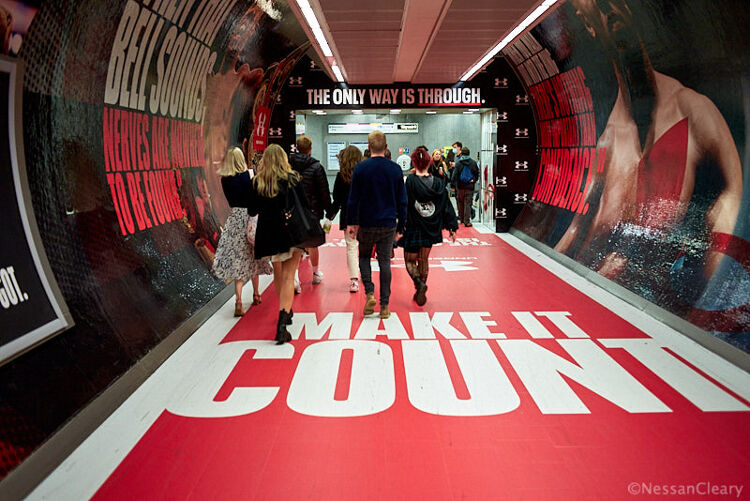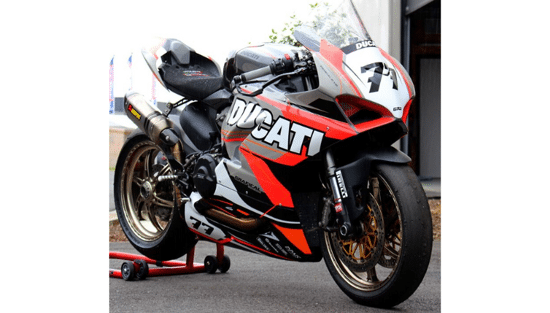The latest trends in out of home advertising

Nessan Cleary shares the current trends regarding out of home adveritsing that features vehicle graphics, sustainability, digital signage and how outdoor advertising is well-suited to internet-memes.
The pandemic and subsequent lockdowns dealt quite a blow to the outdoor advertising business, with little point in advertising as so many people were stuck at home. Even when the lockdowns lifted and we all went back to our normal lives, there was some evidence that habits had changed in the way we all interacted with our environment and that people did not pay the same degree of attention to outdoor signage.
But with the pandemic fading into memory and normalcy reasserting itself, the out of home display sector is expecting further growth over the next few years.
This can cover everything from giant billboards on the roadside through to posters at shopping centres and bus shelters. It seems that almost every surface now offers some kind of advertising opportunity, from park benches to staircases, and this is helping to fuel the growth in the out of home advertising, with compound annual growth of 11 percent according to KPMG Advisory, even while advertising in other areas such as magazines and television have struggled.
Perhaps the most obvious trend is the rapid increase in digital signage, with screens starting to replace traditional printed signage, particularly in fixed locations such as bus stops. The obvious advantage is that the advertising can be rotated so that one screen might be serving up half a dozen different adverts. The adverts can be replaced in real time when the campaign ends, or throughout the day, perhaps in response to changing weather or the results from a sports match or simply to appeal to different market segments. And of course, screens are not limited to fixed images but can also show animated graphics and videos.
Whereas earlier screens were small and best used indoors where they could cope with the ambient lighting, the last couple of years have seen many large screens coming to outdoor locations. There are some interesting variations, including anamorphic screens, where the screen may match the curve on a building, or where two screens overlap on either side of a corner on a building so that a graphic can move from one screen, around the corner to the other side.
Digital signage also fits in with another trend, towards more engagement with audiences, and gathering more feedback on their response. Including interactive elements in the signs is a good way of boosting audience engagement. Some digital signs include touch screens. However, there are also concerns about how to measure the reach of these adverts without impinging on people’s privacy with techniques such as using NFC sensors to record the presence of someone’s smartphone generally seen as a step too far.
This interactivity is not limited to digital screens as conventional printed signs can also include QR codes that lead customers to a website with more information. Most importantly, this engagement can be measured, giving good quality feedback to the advertisers as to how effective each sign is.
Another way to engage audiences is to use giant 3D objects to grab people’s attention. This could include a giant model of a hammer to point people towards a DIY store, or life-sized animals or sculptures scattered around a shopping area to highlight a particular campaign.
 This digital screen on a bus shelter meets old school outdoor advertising. ©Nessan Cleary
This digital screen on a bus shelter meets old school outdoor advertising. ©Nessan Cleary
These days sustainability is a major concern for most brands, who want to assure their customers that they are taking environmental issues seriously. This is harder to achieve with outdoor displays because the graphics have to withstand the effects of weathering and ambient conditions. But there are many new substates that are made with recycled materials that should help the overall carbon footprint associated with a given display. You can add to this by using a local large format printer and installation company to cut the carbon footprint incurred by transporting the graphics to the display site.
In addition, many billboards include some form of lighting so it ought to be straightforward to switch to LEDs to reduce the power consumption. This is both more sustainable and cheaper. An even better option is to use solar power to light the graphic.
Most experts agree that its unlikely that digital signage will completely replace static printed displays. Instead, most advertisers are likely to use a mix of technologies to amplify their messaging in the most cost-effective way. In recent years we’ve seen messaging appearing on many different surfaces, particularly on floors. This is partly driven by all those signs warning us to keep 2m away from other people that appeared during the pandemic, on pavements and walls. There are still plenty of these floor stickers around several years after they were first applied, demonstrating just how long lasting these materials can be.
 A-boards are a cost-effective way of attracting passersby to a retailers offers. ©Nessan Cleary
A-boards are a cost-effective way of attracting passersby to a retailers offers. ©Nessan Cleary
Another form of outdoor display that’s making a comeback is the use of A-boards that can be set up outside a business during trading hours. These are often subject to local council bylaws governing the use of space and pavements, but one lasting benefit of the pandemic is that many councils relaxed these rules to help boost businesses that had been badly hit during the lockdowns.
Another highly visible form of outdoor advertising is vehicle graphics. This can be particularly effective on buses and trains but it also offer a free advertising space to every business with its own van or car, no matter how small. The great advantage is that as that vehicle travels around, so your branding gets more exposure to potential customers. This type of advertising is relatively inexpensive and works just as well if the van is parked outside a customer site or stuck in traffic.
Finally, one other trend that outdoor advertising is very well-suited to is internet-memes where images that have been shared online have snowballed and reached large international audiences, often helped by hashtags. The use of good design with simple phrases can encourage people to stop and take pictures of your billboard and share those images across social media. The results can be unpredictable but such exposure is free and who can argue with free advertising?
To discover the latest content that covers a wide range of sectors including outdoor advertising, digital signage and sustainability sign up for FESPA’s free monthly newsletter FESPA World available in English, Spanish and German.
Interested in joining our community?
Enquire today about joining your local FESPA Association or FESPA Direct
Recent news

The importance of Personalisation in Direct Mail - The Power of Print
Jeroen van Druenen, CCO of Jubels discusses how personalised direct mail, especially print, boosts engagement and ROI by tailoring content to individual recipients. Using variable data printing (VDP), marketers create unique designs and offers, enhancing relevance and fostering stronger customer relationships. Physical mail's tangibility and lasting impact further amplify personalisation's effectiveness.

What are the current trends for digital screens?
Digital screens are evolving rapidly, moving beyond simple signage. MicroLED technology improves resolution and efficiency, while 3D and AR displays offer immersive experiences. AI is transforming content creation and analytics, personalising interactions and optimising screen placement. Larger, wall-sized screens and temporary rentals at events are becoming more common. As screens become ubiquitous, innovation focuses on eye-catching solutions to maintain audience engagement.

Hints and tips for vehicle wrapping success
While rising demand for vehicle wrapping is good news for the industry, this is placing more pressure on companies to deliver quality work at a solid pace. Here, Rob Fletcher picks up some tips from several experts in this sector to help wrappers operate smoothly.

What are the opportunities in Personalisation for Sportwear and Signage?
Rob Fletcher discusses the growing importance of personalisation and digital innovation across sectors. Major brands use personalised print to engage customers and boost sales. Personalised sportswear demand is increasing, and companies like Eurojersey embrace sustainable manufacturing and digital transformation.